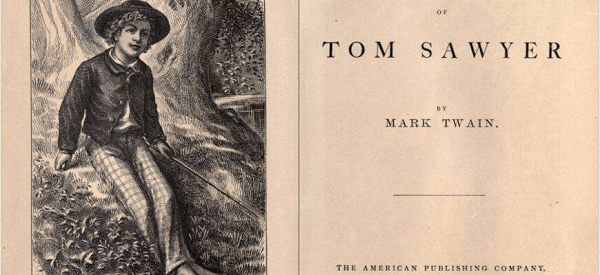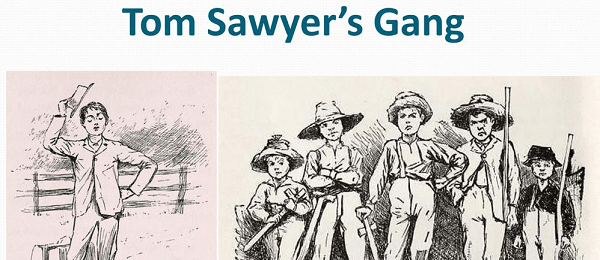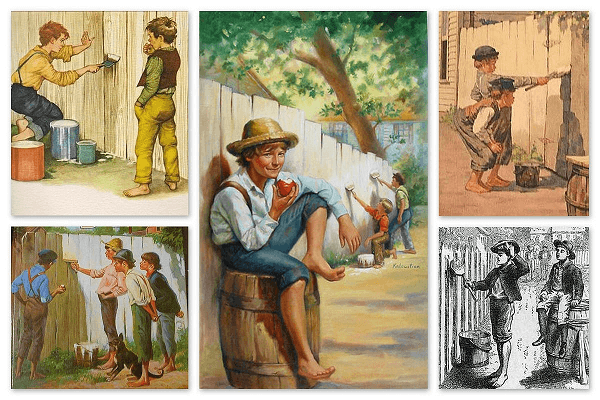The Adventures of Tom Sawyer SummaryIntroduction: Tom Sawyer's AdventuresThe timeless literary masterpiece "The Adventures of Tom Sawyer" has won readers' hearts for decades. This well-known book, written by Mark Twain and first released in 1876, follows the exciting and naughty adventures of the young protagonist, Tom Sawyer. 
Taking place in the fictitious town of St. Petersburg, Missouri, in the middle of the 19th century, the narrative vividly depicts Tom's early escapades and his unrelenting search for adventure and independence. Tom's life is packed with adventurous adventures that keep readers eagerly turning the pages, from his encounters with the mysterious and dangerous Injun Joe to his antics with his band of pirates. The Mississippi River, which acts as Tom's playground and represents his desire for freedom, is critical to the narrative. Tom embarks on endless adventures down the river, pushing the limits of his bravery and inventiveness while doing everything from swimming and fishing to discovering undiscovered tunnels. Tom's relationships, in addition to his mischievous disposition, play a crucial role in the story. His growing infatuation with Becky Thatcher, the vibrant and endearing girl who lives next door, gives the story a hint of innocence and sweetness. Meanwhile, Huckleberry Finn, an outcast and fellow rebel, and his unexpected bond show the strength of companionship and shared experiences. Because of its familiar characters, vivid descriptions, and Mark Twain's brilliant writing, "The Adventures of Tom Sawyer" has endured over time. It captures the spirit of childish exploration and makes readers of all ages feel nostalgic. Join us as we explore the fascinating world of Tom Sawyer, where adventures filled with freedom and companionship await Tom's Playground: The Mississippi River
The mighty Mississippi River evolves into Tom Sawyer's ultimate playground in Mark Twain's "The Adventures of Tom Sawyer," which is more than just a story about a body of water. This famous American river, which stretches for more than two thousand miles, represents liberty, exploration, and the boundless potential of youth. The Mississippi River serves as Tom's entryway to freedom. It's a location where the excitement of discovery and the pull of the unknown can temporarily override regulations and obligations. Tom is comforted by its size, the sound of the water's rhythm, and the mysteries it conceals. Tom uses the river to escape societal restraints because it gives him a feeling of independence that is hard to come by on land. The river offers him a brief respite from the regulations and requirements of adult life, whether he chooses to dive in its chilly depths or go along its currents on a raft. It turns become his particular haven, a place where he can be most authentic. The Mississippi River also comes to represent exploration and adventure. From his contacts with Native American Joe, also known as Injun Joe, to his treasure hunts and run-ins with bandits, Tom's exploits around its coasts and islands are legendary. The river stimulates his sense of surprise and curiosity, which serves as a backdrop for him to let his imagination run wild. Tom's adventures gain depth because of Twain's stunning descriptions of the Mississippi River's splendour and magnificence, giving readers a clear sense of the river's might and appeal. It is a reminder of the size of the world and the limitless opportunities outside of Tom's small town's boundaries. The Mississippi River is both a location and a character, affecting Tom's choices and reshaping his experiences. It embodies the attitude of exploration, liberation, and youthful vigour that appeals to readers of all ages. The Mississippi River's Tom Sawyer's Playground is a living example of how nature can change us and how children's imaginations are limitless. Tom's Gang: Pirates and BBQs
The creation of Tom Sawyer's gang, a group of adolescent misfits who engage in dangerous adventures and imaginative play, is one of Mark Twain's "The Adventures of Tom Sawyer" most endearing features. Tom can assemble a bunch of boys to construct their imaginary world of pirates and picnics because of his captivating personality and storytelling talent. Together, the close-knit members of Tom's gang engage in exhilarating adventures and imaginative realm exploration. The gang members become fearless pirates under Tom's leadership, conquering the vast unknowns of their backyard. They build underground caverns, wear improvised pirate garb, and devise daring plans to loot treasure and trick their fictional adversaries. The gang's rafts are their go-to means of transportation as they negotiate the Mississippi River's perilous waters throughout their pirate adventures. They travel to isolated islands where they encounter fictitious pirates and discover loot, igniting their brilliant imaginations and creating priceless memories. For Tom's gang, though, it's not all high-seas piracy and swashbuckling. They also like lovely picnics where they congregate under trees and gorge on straightforward pleasures. These picnics give children a break from their excursions and a chance to savour youth's basic pleasures while celebrating friendship and laughter. Tom's gang is an example of the power of friendship in overcoming adolescent obstacles because they embody the spirit of teamwork and shared creativity. Each member offers their distinct personality and skills to the group, resulting in a vibrant mix of personalities that fuels the gang's exciting antics. The gang picks up important lessons about friendship, cooperation, and the limitless potential of youth via their experiences. Their adventures capture the spirit of joyful and inventive youth and the uncontrolled energy of youthful adventure. The success of "Pirates and Picnics" is proof of how famous Tom's crew was in "The Adventures of Tom Sawyer." They bring readers to a world where imagination is king, familiar surroundings become exhilarating play areas, and friendship can overcome obstacles. The exploits of Tom's group encourage us to embrace our inner pirates and treasure the friendships that have shaped our life by serving as a reminder of the enchantment and wonder of youth. The Incident of Whitewashing
The Whitewashing Incident is a crucial scene in "The Adventures of Tom Sawyer" that highlights Tom Sawyer's inventiveness and capacity to transform a tedious task into a deft game of manipulation. This incident examines themes of persuasion, social dynamics, and the power of perception, highlighting Tom's mischievous character. Tom is given the arduous duty of whitewashing a fence as a punishment for his mischief, and this is when the story begins. Tom cleverly plans to use the work as an opportunity for entertainment and self-improvement rather than moping about his predicament. He pretends to be enthusiastic as he gets to work and presents the assignment as a coveted and unique opportunity. Tom's companions, initially dubious of his claims, grow curious and envious, wanting to participate in what they now see as a fun activity. Tom cleverly uses reverse psychology to capitalize on their curiosity, claiming to be wholly absorbed in the task at hand and taking great pleasure in his claimed superiority. He deftly tricks his buddies into thinking they are missing out on something unique by being excluded from the activity. Tom's buddies fall for his cunning tricks and voluntarily give up their possessions and advantages to participate in the whitewashing. The whitewashing incident is a metaphor for Tom's capacity to use persuasion to turn a tedious activity into an engaging and appealing experience. It depicts the social dynamics at work, stressing the propensity of people to crave acceptance, look for affirmation, and give in to peer pressure. Tom's success results from his skill in deceiving his friends, his comprehension of human nature, and his ability to use it to his advantage. The whitewashing episode ultimately emphasizes the notion of perception. It shows how quickly people may be persuaded by something's perceived worth and appeal, regardless of its excellence. The incident emphasizes the importance of attitude and viewpoint in influencing one's experience by challenging the idea that work is a burden and encouraging reevaluating tasks and responsibilities thanks to Tom's creative method. Moments like the whitewashing event help "The Adventures of Tom Sawyer" retain its readership. In addition to showcasing Tom's wit and cunning, it provides insightful observations about human nature and the difficulties of social interaction. The Muff Potter Case Huckleberry Finn and Tom: An Unbreakable BondThe friendship between Tom Sawyer and Huckleberry Finn in "The Adventures of Tom Sawyer" is one of literature's most enduring and captivating relationships. Despite having different upbringings and social standings, Tom and Huck develop a strong friendship based on their everyday experiences, respect for one another, and in-depth knowledge of one another. Huck, a freewheeling and independent spirit who lives on the periphery of society, proves to be an odd friend for Tom, a playful and imaginative youngster from a good home. As they face the hardships and adventures of growing up together, their relationship defies society's standards and expectations. Their sincere acceptance of one another is what distinguishes their friendship. Tom sees the essence of the carefree spirit he strives to be in Huck and respects his independence and nonconformity. Huck admires Tom's humour, charm, and bravery in return and values their shared experiences and the sense of community that comes with friendship. When they meet risky scenarios like their encounter with Injun Joe and their participation in the hunt for lost treasure, their friendship is put to the test. Tom and Huck stay faithful to one another despite these difficulties, standing together in the face of difficulty and relying on one another for support and safety. The connection between Tom and Huck is a testament to the strength that may come from genuine companionship and shared experiences. They act as one other's confidantes, criminal partners, and inspirations. Their friendship crosses social barriers and reminds readers of the value of acceptance, comprehension, and sincere relationships. Tom and Huck's strong bond in "The Adventures of Tom Sawyer" is celebrated as proof that friendship can flourish even in the most unlikely circumstances. Their experiences together mould their lives and readers' hearts, constantly reminding them of the joy that comes from accepting people different from ourselves and the transforming power of friendship. Tales of the Graveyard and Haunted Houses Tom Sawyer's Lasting InfluenceThe literary and cultural impact of "The Adventures of Tom Sawyer" has solidified its status as a beloved classic enthralling reader of all ages. Tom Sawyer, a character created by Mark Twain, has left a lasting impression that goes far beyond the confines of the book. Tom Sawyer embodies the spirit of exploration, mischief, and reckless youth. His character impacts readers because he personifies the enduring yearning for independence and the desire to be released from society's restraints. Tom's mishaps and fantastical adventures draw on universal childhood sentiments and serve as a reminder of the rewards and difficulties of growing up. Tom Sawyer also represents the spirit of the Wild West and the exploration of the American frontier, serving as a paradigm for the stereotypical American boy. His persona epitomizes the attitude of independence, dependability, and pursuing one's dreams. The relatability and ageless quality of Tom Sawyer are its main draws. Readers of all ages can relate to the book's themes of friendship, rebellion, natural exploration, and the pursuit of independence. Numerous adaptations, including stage plays, motion pictures, and video games, have honed Tom's wit, inventiveness, and playful charm. Tom Sawyer's significance goes beyond amusement, including its influence on American literature. Through regionalism, colloquial language, and social commentary, Mark Twain pioneered a brand-new writing style that paved the way for other literary revolutions. Twain depicted Tom's exploits wisely, illuminating society's expectations, biases, and the intricacies of human nature. In conclusion, Tom Sawyer's lasting influence can be attributed to its ability to capture the spirit of adventure, the essence of boyhood, and the age-old conflict between conformity and uniqueness. Tom's character continues to enthral readers, imparting worthwhile lessons and serving as a powerful reminder of the timeless ability of storytelling to withstand the test of time and engage readers' hearts and imaginations for countless generations.
Next TopicA Psalm of Life Summary
|
 For Videos Join Our Youtube Channel: Join Now
For Videos Join Our Youtube Channel: Join Now
Feedback
- Send your Feedback to [email protected]
Help Others, Please Share









